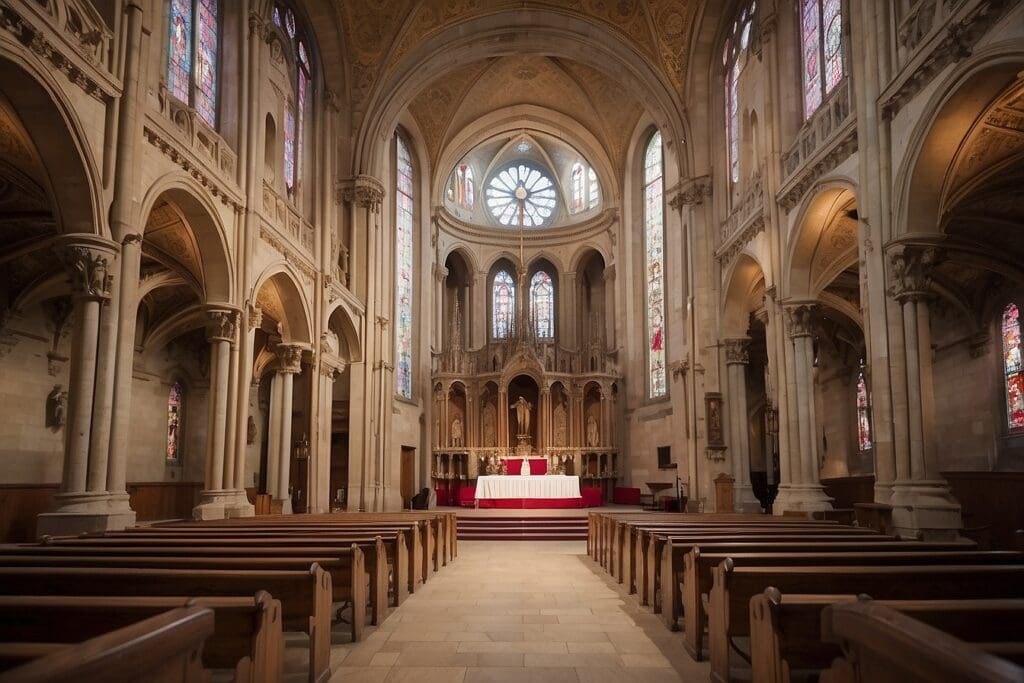Saint Ambroise Church | Paris, France

Updated On: April 16, 2024 by Maha Yassin
The magnificent Saint Ambroise Church stands in the heart of the bustling metropolis of Paris, nestled amidst charming streets and historical landmarks. This timeless place of worship has witnessed centuries of history, offering solace and spiritual refuge to generations of Parisians and visitors alike. This comprehensive article will delve into the rich history, architectural splendour, and cultural significance of Saint Ambroise Church, shedding light on its enduring importance in the vibrant tapestry of Parisian life.
The History of Saint Ambroise Church
The origins of Saint Ambroise Church can be traced back to the 19th century, a period marked by significant urban development in Paris. During the reign of Napoleon III, the city underwent a transformative facelift, which included the construction of numerous churches to cater to the spiritual needs of its growing population. Saint Ambroise Church was part of this ambitious ecclesiastical expansion project.
Construction of the church began in 1863 under the architectural guidance of Théodore Ballu, a prominent figure in 19th-century French architecture. Ballu’s design for Saint Ambroise Church embodies the characteristics of the Neo-Romanesque style, which was in vogue during this period. This architectural style sought to revive elements of Romanesque architecture, characterized by rounded arches, heavy stone masonry, and a sense of grandeur. Saint Ambroise Church was consecrated in 1869, a few years after its construction commenced, and it has since stood as a testament to the architectural and spiritual heritage of the city.
Saint Ambroise Church’s Neo-Romanesque Beauty
Saint Ambroise Church is a visual masterpiece that draws admiration from devout and architectural enthusiasts. Its façade features intricate details and ornate sculptures, showcasing the craftsmanship of the artisans of the time. The prominent rose window, a hallmark of Gothic and Romanesque architecture, adorns the front of the church, casting a kaleidoscope of colours into the interior when the sunlight filters through the stained glass.
Upon entering the church, visitors are greeted by a cavernous nave flanked by soaring columns. The vaulted ceiling, adorned with delicate frescoes and intricate patterns, adds to the awe and reverence that permeates the space. The chancel, bathed in a soft, ethereal light, houses the main altar, a focal point for congregants and a place of profound significance in Catholic worship.
The church’s interior decoration is a testament to the 19th-century penchant for opulence and grandeur. Elaborate frescoes, gilded altarpieces, and intricate woodwork adorn the various chapels and side altars, creating an atmosphere of transcendent beauty. The exquisite stained glass windows, designed by renowned artisans of the period, narrate biblical stories and saints’ lives with a kaleidoscope of colours, infusing the church with an otherworldly luminosity.
Spiritual Significance
Saint Ambroise Church has always been a place of spiritual solace and reflection for the Parisian community. Its role in fostering faith and serving as a sanctuary for prayer and worship cannot be overstated. The church is dedicated to Saint Ambrose of Milan, a revered Christian figure known for his theological contributions and moral teachings. His legacy continues to inspire the faithful who gather here.
Over the years, Saint Ambroise Church has played a vital role in Paris’s religious life. It has hosted countless baptisms, weddings, and funerals, marking significant milestones in the lives of the parishioners. The church’s clergy has provided guidance and support to the local community, offering spiritual counsel and comfort in times of need.
In addition to its regular religious services, Saint Ambroise Church is known for its vibrant musical tradition. The church’s choir, renowned for its exceptional performances, adds a musical dimension to the spiritual experience of congregants and visitors alike. The church’s acoustics make it a favoured venue for classical music concerts, adding to its cultural significance in Paris.
Cultural Reverberations

Beyond its religious role, Saint Ambroise Church has profoundly impacted Paris’s cultural fabric. Its architectural grandeur has made it a subject of fascination for artists, writers, and photographers. The church’s stunning backdrop has been featured in numerous works of art, serving as a muse for creative minds seeking to capture the essence of Paris.
The church has also played a role in historical events. During the tumultuous years of the French Revolution, it witnessed its share of upheaval and transformation. Like many religious institutions, Saint Ambroise Church faced the challenges of a changing political landscape. However, it survived and thrived, a testament to its resilience and enduring importance to the community.
In recent years, the church has become a popular tourist destination, attracting visitors from around the world who seek to explore its architectural beauty and immerse themselves in its rich history. It symbolises Paris’s cultural heritage and religious devotion, offering a glimpse into the city’s multifaceted identity.
Preservation and Restoration Efforts
Preserving Saint Ambroise Church has been a labour of love for generations of Parisians. The ravages of time, environmental factors, and urban development have challenged its maintenance. However, dedicated efforts have been made to ensure the church’s longevity and safeguard its architectural and cultural heritage.
Restoration projects have been undertaken periodically to address structural issues, restore fading frescoes, and preserve the church’s stained glass windows. These endeavours require a delicate balance between modern conservation techniques and the preservation of historical authenticity. Skilled artisans and craftsmen have painstakingly worked to maintain the church’s splendour, allowing it to continue captivating the hearts and minds of all who visit.
A Place of Community and Fellowship
Saint Ambroise Church is not merely a place of stone and mortar; it is a living, breathing community of faith. The parishioners come from diverse backgrounds, united by their shared devotion and love for this sacred space. The church fosters a sense of belonging and fellowship, providing a support system for individuals and families as they navigate life’s joys and challenges.
Community outreach programs, charitable initiatives, and cultural events organized by the church serve as bridges between the parish and the wider community. Saint Ambroise Church is not isolated from the world but instead embraces its role as a beacon of hope and compassion in the heart of Paris.
Beyond the Church: Nearby Points of Interest and Cultural Gems
Saint Ambroise Church is located in a vibrant neighbourhood in Paris, and visitors can explore several attractions and points of interest nearby. Here are some notable attractions:
- Père Lachaise Cemetery: This famous cemetery is one of the most visited worldwide and is just a short walk from Saint Ambroise Church. It’s the final resting place of many renowned figures, including Oscar Wilde, Jim Morrison, and Edith Piaf. The cemetery’s beautiful architecture and peaceful atmosphere make it a unique and reflective place.
- Canal Saint-Martin: A picturesque waterway that runs through the neighbourhood, Canal Saint-Martin offers scenic walks along its tree-lined banks. You can also enjoy boat tours and picnics or visit the charming restaurants and shops that line the canal.
- Le Marais: This historic district is known for its preserved medieval architecture and vibrant cultural scene. Explore narrow cobblestone streets, visit art galleries and boutique shops, and savour delicious French pastries at local bakeries. Le Marais also boasts several museums, including the Picasso Museum and the Musée Carnavalet.
- Bastille: The Place de la Bastille, known for its historical significance in the French Revolution, is far from Saint Ambroise Church. While the original Bastille prison is no longer standing, the square is now home to the Opéra Bastille and offers a lively atmosphere with cafes and shops.
- Oberkampf: This neighbourhood is famous for its nightlife, with numerous bars, clubs, and live music venues. It’s a great place to experience the Parisian nightlife scene and enjoy a night out after exploring the church and its surroundings during the day.
- Marché Bastille: If you’re in the area on a Sunday, don’t miss the bustling Marché Bastille, a lively open-air market that offers fresh produce, artisanal foods, clothing, and unique handmade crafts.
- Parc des Buttes-Chaumont: A bit further from Saint Ambroise Church but worth the visit, this picturesque park is known for its hilly terrain, waterfalls, and a stunning temple on an island in the middle of a lake. It’s a peaceful oasis amid the city, perfect for a stroll or a picnic.
These nearby attractions offer diverse experiences, from history and culture to natural beauty and vibrant city life, making Saint Ambroise Church an excellent starting point for exploring this part of Paris.
Last Words
Saint Ambroise Church is a timeless testament to the enduring power of faith, culture, and architectural beauty. It has weathered the storms of history, serving as a steadfast anchor for the people of Paris and an inspiration to all who visit. Its rich history, architectural splendour, and cultural significance make it a must-see destination for anyone exploring the vibrant tapestry of Parisian life.
As the sun sets over the city of lights and the hues of stained glass windows come to life, Saint Ambroise Church radiates its ethereal beauty and spiritual resonance. It is not just a place of worship; it is a sanctuary for the soul, a guardian of history, and a symbol of Paris’s enduring spirit. Saint Ambroise Church is a testament to the eternal values of faith, art, and community in an ever-changing world.






